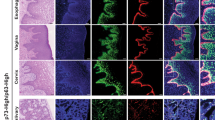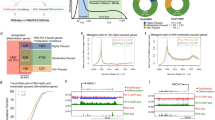Abstract
The p53 tumour suppressor is a transcription factor that regulates the progression of the cell through its cycle and cell death (apoptosis) in response to environmental stimuli such as DNA damage and hypoxia1,2. Even though p53 modulates these critical cellular processes, mice that lack p53 are developmentally normal3, suggesting that p53-related proteins might compensate for the functions of p53 during embryogenesis. Two p53 homologues, p63 and p73, are known4,5 and here we describe the function of p63 in vivo. Mice lacking p63 are born alive but have striking developmental defects. Their limbs are absent or truncated, defects that are caused by a failure of the apical ectodermal ridge to differentiate. The skin of p63-deficient mice does not progress past an early developmental stage: it lacks stratification and does not express differentiation markers. Structures dependent upon epidermal–mesenchymal interactions during embryonic development, such as hair follicles, teeth and mammary glands, are absent in p63-deficient mice. Thus, in contrast to p53, p63 is essential for several aspects of ectodermal differentiation during embryogenesis.
This is a preview of subscription content, access via your institution
Access options
Subscribe to this journal
Receive 51 print issues and online access
$199.00 per year
only $3.90 per issue
Buy this article
- Purchase on SpringerLink
- Instant access to full article PDF
Prices may be subject to local taxes which are calculated during checkout






Similar content being viewed by others
References
Livingston, L. R. et al. Altered cell cycle arrest and gene amplification potential accompany loss of wild-type p53. Cell 70, 923–935 (1992).
Lowe, S. W., Schmitt, E. M., Smith, S. W., Osborne, B. A. & Jacks, T. p53 is required for radiation-induced apoptosis in mouse thymocytes. Nature 362, 847–849 (1993).
Donehower, L. A. et al. Mice deficient for p53 are developmentally normal but susceptible to spontaneous tumours. Nature 356, 215–221 (1992).
Kaghad, M. et al. Monoallelically expressed gene related to p53 at 1p36, a region frequently deleted in neuroblastoma and other human cancers. Cell 90, 809–819 (1997).
Schmale, H. & Bamberger, C. Anovel protein with strong homology to the tumor suppressor p53. Oncogene 15, 1363–1367 (1997).
Trink, B. et al. Anew human p53 homologue. Nature Med. 4, 747–748 (1998).
Osada, M. et al. Cloning and functional analysis of human p51, which structurally and functionally resembles p53. Nature med. 4, 839–843 (1998).
Yang, A. et al. p63, a p53 homolog at 3q27-29, encodes mutliple products with transactivating, death-inducing, and dominant-negative activities. Mol. Cell 2, 305–316 (1998).
Valancius, V. & Smithies, O. Double-strand gap repair in a mammalian gene targeting reaction. Mol. Cell. Biol. 11, 4389–4397 (1991).
Cygan, J. A., Johnson, R. L. & McMahon, A. P. Novel regulatory interactions revealed by studies of murine limb pattern in Wnt-7a and En-1 mutants. Development 124, 5021–5032 (1997).
Voge., A., Rodriguez, C. & Izpisua-Belmonte, J. C. Involvement of FGF-8 in initiation, outgrowth and patterning of the vertebrate limb. Development 122, 1737–1750 (1996).
Wang, Y. & Sassoon, D. Ectoderm-mesenchyme and mesenchyme-mesenchyme interactions regulated Msx-1 expression and cellular differentiation in the murine limb bud. Dev. Biol. 168, 374–382 (1995).
Grieshammer, U., Minowada, G., Pisenti, J. M., Abbot, U. K. & Martin, G. R. The chick limbless mutation causes abnormalities in limb bud dorsal–ventral patterning: implications for the mechanism of apical ridge formation. Development 122, 3851–3861 (1996).
Summerbell, D., Lewis, J. H. & Wolpert, L. Positional information in chick limb morphogenesis. Nature 244, 492–496 (1973).
Zhou, P., Byrne, C., Jacobs, J. & Fuchs, E. Lymphoid enhancer factor 1 directs hair follicle patterning and epithelial cell fate. Genes Dev. 9, 700–713 (1995).
Roop, D. R., Krieg, T. M., Mehrel, T., Cheng, C. K. & Yuspa, S. H. Transcriptional control of high molecular weight keratin gene expression in multistage mouse skin carcinogenesis. Cancer Res. 48, 3245–3252 (1988).
Rothnagel, J. A., Mehrel, T., Idler, W. W., Roop, D. R. & Steinert, P. M. The gene for mouse epidermal filaggrin precursor. Its partial characterization, expression, and sequence of a repeating filaggrin unit. J. Biol. Chem. 262, 15643–15648 (1987).
Mehrel, T. et al. Identification of a major keratinocyte cell envelope protein, loricrin. Cell 71, 1103–1112 (1990).
Byrne, C., Tainsky, M. & Fuchs, E. Programming gene expression in developing epidermis. Development 120, 2369–2383 (1994).
Hardy, M. H. & Vielkind, U. Changing patterns of cell adhesion molecules during mouse pelage hair follicle development. 1. Follicle morphogenesis in wild-type mice. Acta Anal. 157, 169–182 (1996).
Bickenbach, J. R., Greer, J. M., bundman, D. S., Rothnagel, J. A. & Roop, D. R. Loricrin expression is coordinated with other epidermal proteins and the appearance of lipid lamellar granules in development. J. Invest. Dermatol. 104, 405–410 (1995).
Hinchliffe, J. R. & Ede, D. A. Cell death and the development of limb form and skeletal pattern in normal and wingless (ws) chick embryos. J. Embryol. Exp. Morpho. 30, 753–772 (1973).
Prahlad, K. V., Skala, G., Jones, D. G. & Briles, W. E. Limbless: a new genetic mutant in the chick. J. Exp. Zool. 209, 427–434 (1979).
McNeish, J. D., Scott, W. J. J & Potter, S. S. Legless, a novel mutation found in PHT1-1 transgenic mice. Science 241, 837–839 (1988).
Ramirez-Solis, R., Liu, P. & Bradley, A. Chromosome engineering in mice. Nature 378, 720–724 (1995).
Osoegawa, K. et al. An improved approach for construction of bacterial artificial chromosome libraries. Genomics 51, 1–8 (1998).
Liu, P., Zhang, H., McLellan, A., Vogel, H. & Bradley, A. Embryonic lethality and tumorigenesis caused by segmental aneuploidy on mouse chromosome 11. Genetics 150, 155–1168 (1998).
Bradley, A. in Teratocarcinomas and Embryonic Stem Cells — a Practical Approach (ed. Robertson, E. J.) 113–151 (IRI, Oxford, 1987).
Wilkinson, D. G. In situ hybridization. A practical approach. (ed. Wilkinson, D. G.) (Oxford University Press, Oxford, 1992).
Wang, X. J., Greenhalgh, D. A., Lu, X. R., Bickenbach, J. R. & Roop, D. R. TGF alpha and v-fos cooperation in transgenic mouse epidermis induces aberrant keratinocyte differentiation and stable, autonomous papillomas. Oncogene 10, 279–289 (1995).
Zheng, B., Mills, A. M. & Bradley, A. Asystem for rapid generation of coat color tagged knockouts and defined chromosomal rearrangements in mice. Nucleic Acids Res.(in the press).
Acknowledgements
We thank S. Rivera for assistance with gene targeting, Y.-C. Cheah for blastocyst injection and for help with mapping the p63 locus, H. Zhang for sequencing, Y. Qi and J. Wesley for assistance in genotyping and maintaining the mouse colony, S. Vaishnav for histology and in situ hybridization, R. Johnson for constructs, for advice, and for critically reading the manuscript, and members of A.B.'s laboratory, particularly G. Luo and M. Mills for discussions, P. Biggs for reviewing the text, and S. Perez for help in preparing it. A.B. is an Investigator and A.M. is a Research Associated with the Howard Hughes Medical Institute. A.B. and D.R.R. acknowledge support from the National Cancer Institute.
Author information
Authors and Affiliations
Corresponding author
Rights and permissions
About this article
Cite this article
Mills, A., Zheng, B., Wang, XJ. et al. p63 is a p53 homologue required for limb and epidermal morphogenesis. Nature 398, 708–713 (1999). https://doi.org/10.1038/19531
Received:
Accepted:
Issue Date:
DOI: https://doi.org/10.1038/19531
This article is cited by
-
The urothelial gene regulatory network: understanding biology to improve bladder cancer management
Oncogene (2024)
-
Unmasking the biological function and regulatory mechanism of NOC2L: a novel inhibitor of histone acetyltransferase
Journal of Translational Medicine (2023)
-
DARPins detect the formation of hetero-tetramers of p63 and p73 in epithelial tissues and in squamous cell carcinoma
Cell Death & Disease (2023)
-
p63: a crucial player in epithelial stemness regulation
Oncogene (2023)
-
Disease-related p63 DBD mutations impair DNA binding by distinct mechanisms and varying degree
Cell Death & Disease (2023)



